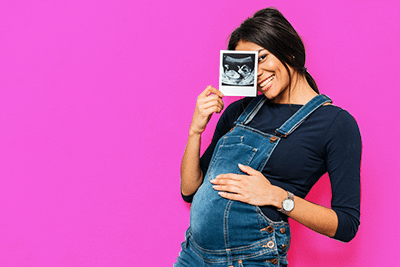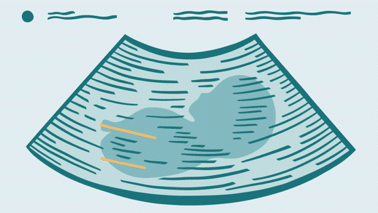Published on October 18th, 2020

When you’re curious about your baby’s gender, you might turn every little thing into a gender prediction test: your food cravings, the Earth’s position in relation to Mercury, the spilled coffee that totally looks like the female gender symbol, and even a tiny little nub on a super-grainy ultrasound of your unborn baby.
Wait… nub?
If you’re itching to start planning your nursery theme and phoning loved ones, you might not need to wait as long as you initially thought. According to the Nub Theory, which is often related to the Skull Theory and Ramzi Theory, the direction of your baby’s nub could reveal their gender as early as your first ultrasound.
So what is the nub theory? And should you trust it enough to pick out paint colors?
Nub Theory—Explained
Nub Theory is a gender determination method. It is the belief that your baby’s genital nub, or genital tubercle, which develops into either the penis or clitoris, can determine your baby’s gender before the external genitals even begin to take shape. Your child’s external genitals start developing around week 4 of your pregnancy, but boy and girl genitalia are nearly identical in an ultrasound until around 18-20 weeks. That’s why mums typically learn their baby’s sex at the anatomy ultrasound around 18-20 weeks.
According to the Nub Theory, you don’t have to wait those 18 long weeks. You could find out at your second ultrasound.
Typically, you’ll have 3 ultrasounds during pregnancy:
- Dating ultrasound – While not always required, dating ultrasound appointments occur between week 6 and week 9 of pregnancy. It’s used to:
- Confirm the pregnancy and estimate the due date based on your last period and the baby’s development.
- Determine if you’re having multiples or if there’s just one little bun in the oven.
- Listen to the baby’s heartbeat—but you may have to wait until week seven to hear your little one’s first flutters.
- End-of-first trimester ultrasound – Most future mummies get a glimpse of their little nugget between week 11 and week 14. “Glimpse” is undoubtedly an accurate description for what you’ll be seeing—at this stage, your baby-to-be looks more like a bean than a human, but you’ll still be able to:
- See your baby’s head, face, arms, and legs.
- Double-check the baby’s due date now that growth is farther along.
- Potentially predict the baby’s gender, according to the Nub Theory (more on that shortly).
- Second trimester ultrasound – Between week 18-20 of your pregnancy, you can learn a ton about your little one, including:
- Confirmation that vital organs are developing properly.
- Whether or not there are any noticeable abnormalities.
- Body measurements, including head and abdomen circumference, and femur length.
- The baby’s gender—by now, the baby’s genitalia is officially developed enough for the doctor to give you the news!
But is there a way to determine the child’s gender before the external genitals have formed? Does the nub provide some magical look-see into the future, like a crystal ball or Mayan calendar prediction?
Putting the Nub in Nub Theory
The nub is a protruding mass of tissues that starts developing around 4 weeks into the pregnancy, but it’s hardly noticeable by ultrasound, if at all. Until about 14 weeks along, boy nubs and girl nubs are exactly the same size, so you won’t acquire much useful information there.
So maybe size won’t tell you anything until the second trimester ultrasound, but what about the angle?
How To Read The Nub according to Nub Theory
The nub theory is a gender prediction method that requires a sagittal view (a clear profile) at the end-of-first trimester ultrasound. To perform the test, you’ll measure the angle of the nub in relation to the line of the baby’s spine, so you’ll need an unobstructed view of both. Nub theory aficionados refer to this as “the angle of the dangle” (seriously, we’re not making this up):
- Baby boy – Any angle of 30 degrees or higher is said to be indicative of a male baby . For some, it can be a bit difficult to determine precisely 30 degrees, but if the nub is pointing definitively up and away from the spine, this suggests you’ve got a rambunctious little lad on the way.

(Photos from Healthline)
- Baby girl – Alternatively, an angle below 10 degrees is supposedly the marker of a girl. If the nub runs parallel to the spine or bends slightly towards it, you might find yourself with a darling daughter.

You might be thinking, What about all those degrees between 10 and 30? If the nub is anywhere between 10 and 30 degrees during your fetal ultrasound, you won’t be able to use the Nub Theory to determine gender.
The Truth About The Nub Theory
This theory has many proponents, spread far and wide across the Internet, who claim total accuracy with their end-of-first trimester ultrasounds. Of course, some parents-to-be who used this method to predict females will have sweet baby girls while others whose nubs suggested male will come home with darling little boys. Does that make it accurate?
Not exactly. But it’s not total nonsense, either.
What The Data Says
Several studies have sought to determine how accurate ultrasound predictions are before the typical second trimester anatomy ultrasound. While the data vary slightly between each study, one thing is overwhelmingly true: the earlier the ultrasound, the less accurate the results (and yes, this holds up for the nub test, too).
- Nub Study #1 – The Australian Journal of Ultrasound in Medicine conducted a study on sonographic gender prediction that showed 54% accuracy for fetuses before 12 weeks—practically the same as if determined by chance. However, after 14 weeks, the accuracy shot up to 100% (according to this study, anyway).
- Nub Study #2 – Another study on the accuracy of ultrasounds at around 11-14 weeks (or the end-of-first trimester ultrasound) looked at both the feasibility and accuracy of gender predictions based on the genital tubercle axis:
- Feasibility –Can reading the nub angle—as in, actually seeing it and assessing the angle—truly be done? Is it possible to make a prediction based on available imaging technology? The most common factor preventing a potential reading was that the nub was at an angle between 10 and 30 degrees; other issues included the fetus’s position and the body mass of the mum-to-be. At under 11.5 weeks, feasibility was only 39.1%. At 11.5-12 weeks, it remained relatively low at 63.5%.
- Accuracy – Was this prediction correct or precise, as measured against a future outcome? Again, at 11.5 weeks, the results were quite low, with an accuracy of 30.5%. At 11.5-12 weeks, it increased quite a bit to 75.0%, and these upward trends continued for both measurements.
- Nub Study #3 – The Journal of Medical Ultrasound published a study on end-of-first trimester ultrasound accuracy, which again illustrated a similar curve: at less than 12 weeks pregnant, the results were significantly less accurate than later in the gestational period.
It makes sense that the further along you are in the pregnancy, the more accurate sonographic gender prediction will be—that’s why ultrasound technicians wait until the second trimester to tell you the gender of your little peanut.
Is the Nub Theory accurate?
Despite some semi-persuasive data and loads of anecdotal evidence on Internet forums, you probably shouldn’t rush home to start painting the nursery or picking out adorable outfits based on the nub test alone.
There are several reasons why this theory should be approached with caution, especially when it comes to making plans:
- A wide window for end-of-first-trimester ultrasounds – Most end-of-first trimester scans happen between 11 and 14 weeks. There is a considerable discrepancy in fetal development between 11 and 14 weeks, or even between 12.5 and 13 weeks. Your sonogram appointment could be during the phase where the nub test is more often wrong than right.
- Amateur vs. professional interpretations – Highly-trained researchers performed the studies listed above, and even then, the accuracy was questionable at many stages of pregnancy. Do-it-yourself attempts to determine gender based on nub placement are likely to be even less statistically valid than anything scientists figured out in a lab.
- It relies on very particular conditions – The nub test only works—if it works—under optimal scanning conditions, including the fetus’ angle, image clarity, and physical health of the mum. Nub Theory research only used images that met these high standards.
Some people swear by the test, claiming accuracy across multiple pregnancies and among all their friends. But these “accurate results” may come to fruition in the same way that your horoscope will “totally come true” some days, and your fortune cookie might “perfectly predict the future.”
Snub the Nub with the SneakPeek Early Gender DNA Test
While the speculation might keep you and your gal pals entertained, there’s an easier, accurate way to learn your baby’s gender even earlier: The SneakPeek Early Gender DNA Test, which is a new and innovative gender blood test.
You can use SneakPeek’s safe, simple test as early as 6 weeks into pregnancy. Once you order the kit, all you have to do is collect the sample at home and ship it off to SneakPeek Labs in the included prepaid packaging.
In return, you’ll get scientifically-validated results with over 99% accuracy1.
Now, you can start taking your food cravings at face-value, quit checking whether Mercury’s in retrograde, wipe up the coffee rather than analyze it for symbols, and proudly place your ultrasound image on the fridge rather than under a microscope.
SneakPeek can all but guarantee if you’re having a precious little girl or a sweet baby boy—that’s better than any sign from above (or within).
Continue reading for an article that will explore the genes inherited from mothers only!
Editorial Policy
At SneakPeek, our commitment is to provide accurate, up-to-date, and reliable information to empower our readers. Our content is thoroughly researched, reviewed by medical experts, and fact-checked to ensure its credibility. We prioritize the well-being and education of our readers, and our editorial policy adheres to the highest standards of integrity and accuracy in all our articles.
This post has been reviewed for accuracy by the following medical professional:
Katie Smith is a seasoned Certified Nurse Midwife and a nurturing mother to six children, offering a unique blend of professional expertise and personal experience. She is the founder of Birth Your Way Midwifery and Women’s Wellness Center in Bay County, Florida. Katie's comprehensive approach to care is informed by her hands-on experience in motherhood and her passion for empowering women through their birthing journey. Her dedication extends beyond her center as she actively engages in community wellness and family health education.
Sources:
Healthline. Can Using Nub Theory Reveal If You’re Having a Boy or a Girl? https://www.healthline.com/health/pregnancy/nub-theory
Mayo Clinic. First trimester screening. https://www.mayoclinic.org/tests-procedures/first-trimester-screening/about/pac-20394169
Parents. What to Expect at Your First Ultrasound. https://www.parents.com/pregnancy/my-baby/your-babys-first-ultrasound/
Australian Journal of Ultrasound in Medicine. Accuracy of sonographic fetal gender determination: predictions made by sonographers during routine obstetric ultrasound scans. https://www.ncbi.nlm.nih.gov/pmc/articles/PMC5024945/
Biomed Pap Med Fac Univ Palacky Olomouc Czech Repub. Ultrasound evaluation of fetal gender at 12-14 weeks. https://biomed.papers.upol.cz/pdfs/bio/2012/04/05.pdf
Journal of Medical Ultrasound. Learning Curve in Determining Fetal Sex by First Trimester Ultrasound Scan. https://www.sciencedirect.com/science/article/pii/S0929644115001046
Healthline. When Can You Hear Your Baby’s Heartbeat on Ultrasound and By Ear? https://www.healthline.com/health/pregnancy/when-can-you-hear-babys-heartbeat







